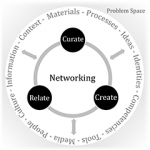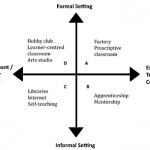Abstract

The emergence of the makerspace movement offers tremendous potential to transform learning. Learning by making, while ancient in practice, has evolved due to the development and confluence of developments in computing, communications technologies, pedagogy, and library science. In particular, online networking has enabled learners to share and engage with ideas and materials in a uniquely 21st century fashion. The makerspace activity process (MAP) framework illustrates how makerspace activities—curating, relating, and creating—are intertwined through networking practices. Makerspaces are highly contingent and transformative; both the nature of the makerspace and the participants transform each other through interaction. For those educators who find it difficult to integrate within formal curricula and assessment practices, the MAP framework provides a guide for facilitating and assessing learner activity in educational makerspaces. The framework is useful for educators at all levels from kindergarten to post-secondary.

Marguerite Koole (University of Saskatchewan, Canada), Jean-François Dionne (University of Saskatchewan, Canada), Evan Todd McCoy (University of Saskatchewan, Canada) and Jordan Epp (University of Saskatchewan, Canada)
Copyright: © 2017 |Pages: 20
Available here: http://www.igi-global.com/chapter/makerspaces/174054